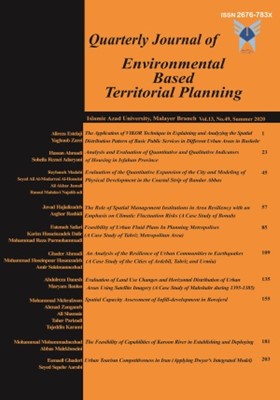An Analysis of the Resilience of Urban Communities to Earthquakes (A Case Study of the Cities of Ardebil, Tabriz and Urmia)
Subject Areas :
Ghader ahmadi
1
,
mohammad hosein pour hasan zadeh
2
![]() ,
amir soleimannezhad
3
,
amir soleimannezhad
3
1 - Assistant Professor of urban planning, urmia University, Urmia, Iran
2 - Assistant Professor of urban planning, urmia University, Urmia, Iran
3 - Assistant Professor of urban planning, urmia University, Urmia, Iran
Keywords: resilience, Vulnerability, Ardebil, natural disasters, Tabriz and Urmia, resilient societies,
Abstract :
The earthquake is one of the natural disasters with which the majority of cities in all countries encountered. This issue has been generally reinforced by the widest unconsidered human intervention in natural environment like unconventional constructions in the earthquake fault range, lack or neglecting of criteria and constructions standards. Increasing the resilience of cities to natural disasters specifically earthquake is greatly effective in reducing damages and also is effective for recovery periods of communities. Accordingly, the present study seeks to evaluate and compare the resilience of Ardebil, Tabriz, and Urmia cities in four social, economic, institutional and physical-environmental dimensions. The research method is descriptive - analytic and its nature is an applied one. In this research, the theoretical framework of the research was initially carried out through the collection of information and the use of documentary studies. In order to investigate the resilience of the understudied cities, resilience criteria and sub-criteria were determined by examining the previous studies. Then the values of each of the indicators were obtained by field studies and approved projects in each of the understudied areas and the obtained data were analyzed using SPSS software. The results showed that the cities of Ardebil and Tabriz were in a favorable situation with an average score of 3.35 and 3.33 respectively (higher than the average of 3), but the city of Urmia with an average of 2.71 (below the average of 3) was in an unsatisfactory situation in case of crises.
19. Davis, I. & Izadkhah, Y.2006. Building Resilient Urban Communities. Article from OHI, 31, 1, 11-21.
20. Desouza, Kevin C, H. & Flanery, Trevor.2013. Designing, planning, and managing resilient cities: A conceptual framework, Cities 35, pp. 89–99.
21. Klein, R. J. N. and Thomalla, F.2003. Resilience to Natural Hazards: How Useful is this Concept, Environmental Hazards, Vol. 5, No. 1–2, PP. 35–45.
22. Normandin, J._M, Therrien M._C, Tanguay G.A.2011. City strength in times of turbulence: strategic resilience indicators, Urban Affairs Association 41 st Conference, new Orleans.
23. Norris, Fran H & Stevens, Susan P.2007. Community Resilience as a Metaphor, Theory, Set of Capacities, and Strategy for Disaster Readiness, Springer Science.
_||_


